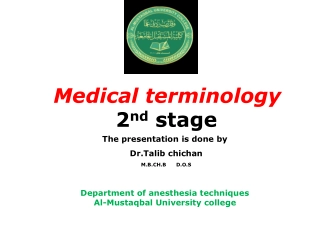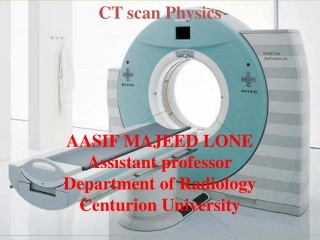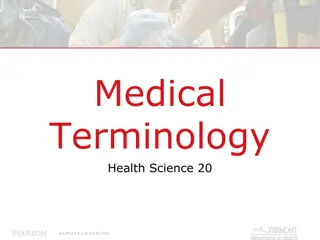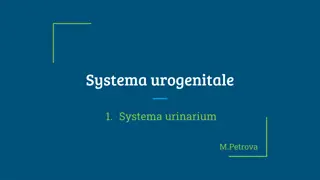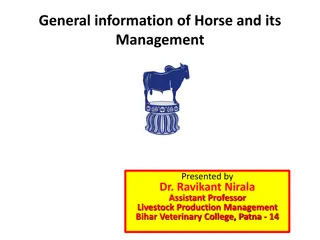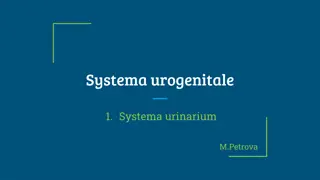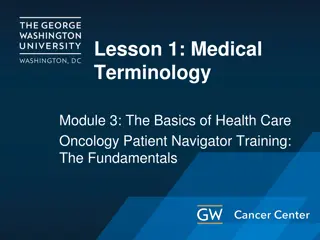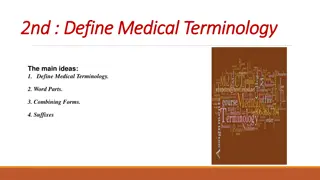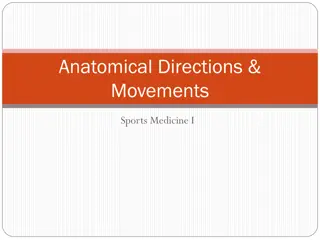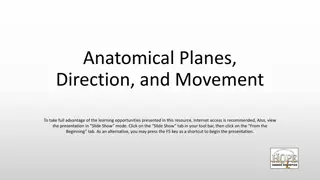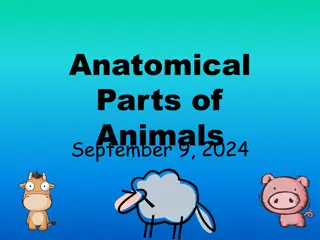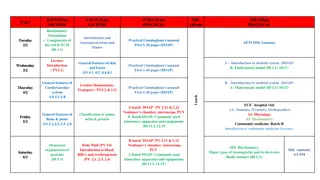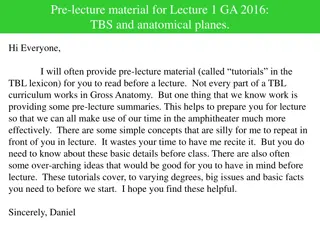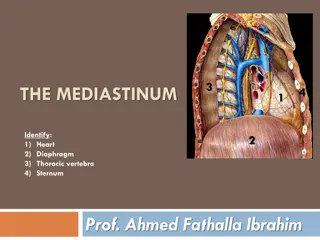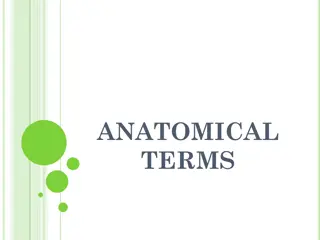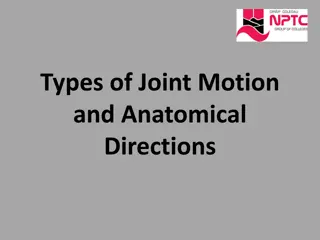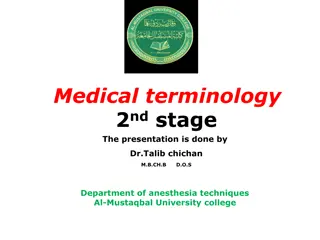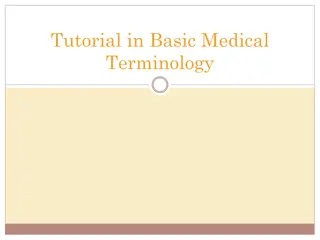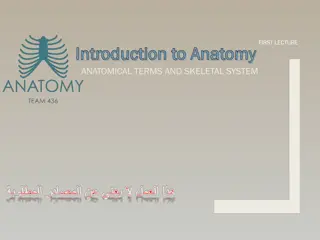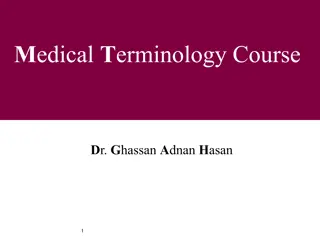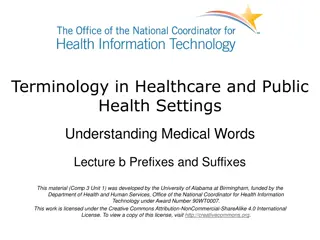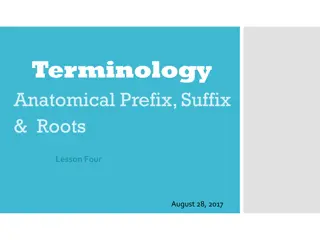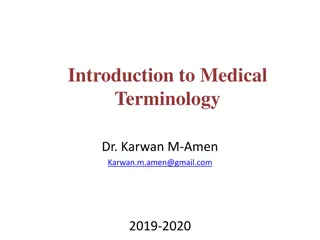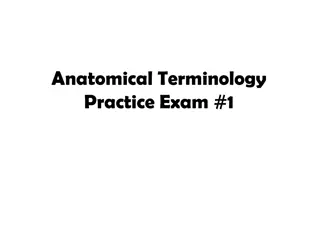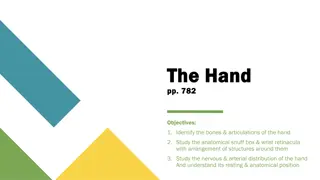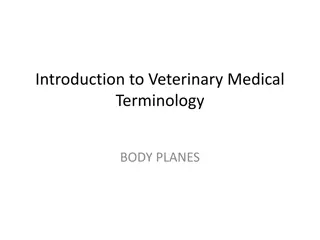Medical Terminology - 2nd Stage
Dr. Talib Chichan presents medical terminology related to the gastrointestinal system. Learn about the anatomy, terminology, and common conditions.
2 views • 18 slides
Evolution of CT Scan Technology and Terminology
The development of CT scanning technology revolutionized medical imaging. Godfrey Hounsfield introduced computerized axial transverse scanning in 1972, with Allan Cormack's mathematical contributions. Dr. Robert Ledley created the first whole-body CT scanner in 1974. Dr. Willi Kalender further advan
1 views • 121 slides
Understanding Medical Terminology: Suffixes and Their Meanings
Dive into the realm of medical terminology suffixes and their significance in altering the meanings of terms. Explore various types of suffixes like grammatical, diagnostic, pathological, surgical procedure, and disease-related. Learn examples of noun suffixes and their definitions, shedding light o
2 views • 12 slides
Understanding Medical Terminology: Prefixes and Suffixes in Healthcare
Medical terminology involves compound words that define aspects of the body and diseases. This lecture covers the basics of medical terms, including word roots, combining forms, prefixes, and suffixes. Proper pronunciation is crucial in healthcare to avoid potentially life-threatening errors. Exampl
3 views • 27 slides
Understanding Medical Terminology: Suffixes and Their Importance in Healthcare
Explore the significance of suffixes in medical terminology, how they modify word meanings, and the importance of dissecting terms to understand their components. Learn how suffixes denote conditions, aid in pronunciation, and convey crucial information in healthcare terminology.
4 views • 65 slides
Introduction to Cryptography: Basics, Terminology, and Significance
Cryptography is the study of techniques used for secure communication, involving creating programs to protect private messages. This overview covers the history, terminology, and significance of cryptography. Explore the basics, cyphers, and the importance of encryption in safeguarding sensitive dat
3 views • 15 slides
Understanding Prism Terminology and Light Deviation
Prisms are optical devices that deviate light without changing its vergence. This module explores the various terminology associated with prisms, including Apex, Base, Refracting Angle, and Angle of Deviation. The passage of light through a prism follows Snell's Law, where the ray is deviated toward
4 views • 42 slides
Update from the Library of Congress on Indigenous Peoples' Land Acknowledgment and Terminology Challenges
The Library of Congress recognizes the importance of acknowledging Native American land and is committed to rectifying incorrect and offensive subject headings for Indigenous peoples. Challenges in terminology and necessary changes are addressed to show respect for Native cultures.
1 views • 18 slides
Understanding Learning Disabilities: Types, Causes, and Terminology Changes
Explore the various types and causes of learning disabilities, including Down syndrome and genetic, inherited, metabolic, and intrauterine factors. Learn how terminology has evolved over time to promote respectful language and understanding. Gain insights into models of care and national frameworks
0 views • 8 slides
Medical Terminology Health Science 20
Medical terminology is a specialized language used in healthcare to describe medical concepts concisely. It consists of prefixes, root words, and suffixes, which can be broken down to define complex terms. Utilizing proper medical terminology enhances communication among healthcare professionals and
3 views • 16 slides
Principles of Teaching Grammar: Key Recommendations and Session Outline
Explore the principles of teaching grammar outlined by Dr. Rowena Kasprowicz and Professor Emma Marsden, focusing on providing explicit descriptions, practice in input and productive language use, utilization of standard terminology, and building on knowledge from key stage 2. The session outline co
3 views • 43 slides
Understanding the Urinary System: Anatomical Structures and Terms
This informative content delves into the anatomical structures and terms related to the urinary system, covering key components such as the kidneys, ureters, bladder, and urethra. It explains important terms like renal pyramids, calices, and ureter dexter/sinister, providing a comprehensive overview
1 views • 8 slides
Horse Management and Common Terminology Overview
Dr. Ravikant Nirala, Assistant Professor at Bihar Veterinary College, presents comprehensive information on horse management and common terminology associated with equine production. The content covers the position of horses in the animal kingdom, terminology for different horse genders and ages, mi
0 views • 15 slides
Overview of Urinary System Anatomy and General Terminology
This content provides detailed information on the anatomy of the urinary system, including the kidneys, ureters, bladder, and urethra. It explains anatomical terms, Greek term elements related to the system, and general terms for urine and urination. Additionally, it covers urinary dysfunctions such
2 views • 8 slides
Basics of Medical Terminology in Health Care Oncology
This module provides training on medical terminology basics for patient navigators in oncology. It covers defining terms using prefixes, root words, and suffixes, common oncology words, and available resources. Learn how to approach medical terminology effectively by understanding word roots and com
1 views • 20 slides
Economic Aspects of Applied Plant Anatomy in Practical Use
Applied Plant Anatomy involves the practical application of anatomical knowledge in various fields such as identification, classification, taxonomic applications, medicinal plants, food safety, wood analysis, forensic investigations, and more. By understanding plant anatomy, professionals can utiliz
0 views • 26 slides
Understanding Medical Terminology: Key Components and Usage
Medical terminology is a specialized language used by healthcare professionals worldwide, rooted in Greek and Latin words. It comprises word parts, such as roots, prefixes, and suffixes, which are crucial for forming and understanding medical terms. The combining forms aid in pronunciation and help
2 views • 17 slides
Understanding ICD-11 and ICHI: Terminology, Overview, and Purpose
International Classification of Diseases (ICD-11) and International Classification of Health Interventions (ICHI) provide a comprehensive framework for recording and analyzing health data globally. The system ensures semantic interoperability, integrates terminology and classification, and supports
4 views • 21 slides
Understanding Anatomical Directions and Movements in Sports Medicine
Anatomical directions play a crucial role in explaining the precise location of body structures in relation to each other. They are utilized regardless of the actual position of the body, with terms like superior, inferior, anterior, posterior, medial, lateral, proximal, and distal aiding in clear c
0 views • 38 slides
Understanding Anatomical Planes, Directions, and Movement in Human Body
Explore the fundamentals of anatomical planes, direction, and movement in the human body. Learn about the three cardinal planes of motion, anatomical positions, directions, and their significance in describing body structures and movements. Gain insights into the anatomical position and how it relat
1 views • 35 slides
Understanding Quarantine Structure and Terminology
Explore the structure and terminology of quarantine, including its purpose, restrictions, and terminology for zones and premises. Learn about the different types of quarantine premises, such as infected, contact, suspect, and at-risk premises, and understand the necessary biosecurity measures. Gain
0 views • 23 slides
Anatomical Parts of Different Animals Visual Guide
Explore the detailed anatomical parts of various animals like dairy cow, hog, sheep, and more through informative images. Learn about the different body regions and components such as neck, rump, shoulder, hoof, and more.
0 views • 7 slides
Modernizing Organ Donation Laws: The Uniform Anatomical Gift Act of 2006
The Uniform Anatomical Gift Act (UAGA) of 2006 aims to enhance the donation process by introducing new definitions, emphasizing personal autonomy, and providing clearer rules. It addresses the need for uniformity, updates to reflect current practices, and modernizes the Act to ensure a smoother orga
0 views • 14 slides
Biochemistry Orientation, Cell Components, Anatomical Terms, and Practical Sessions Week 1
Delve into the world of Biochemistry with an orientation on cell components and the Extracellular Matrix (ECM). Explore anatomical terms and planes, setting the foundation for further learning. Engage in practical sessions using Cunningham's manual for hands-on experience in the field. Week 1 is pac
0 views • 38 slides
Pre-Lecture Material for Gross Anatomy: TBS and Anatomical Planes
Understand the Typical Body Segment (TBS) concept, a transverse section through the human body, and the importance of anatomical planes for orienting and dividing the body into sagittal, coronal, and transverse sections. Prepare effectively for Gross Anatomy lectures by grasping these foundational c
0 views • 6 slides
Understanding the Mediastinum: Boundaries, Divisions, and Contents
The mediastinum is a critical anatomical region in the thoracic cavity that houses various structures like the heart, thoracic vertebrae, diaphragm, and sternum. Divided into superior and inferior sections, it contains essential organs, vessels, nerves, and lymph nodes. Understanding its boundaries,
0 views • 25 slides
Anatomical Terminology Evolution: From Latin to Modern Standards
Anatomical terms have evolved over centuries into a unified nomenclature system known as Nomina anatomica. This system, initially based on Latin and Greek words, faced confusion and disagreement among anatomists, leading to revisions and the introduction of modern anatomical terminology. The structu
0 views • 27 slides
Essential Joint Motions and Anatomical Directions Explained
Explore various types of joint motions such as abduction, flexion, rotation, and more, along with anatomical directions like anterior, posterior, superior, and inferior. Understand the body's movements and positions with detailed illustrations in the anatomical context.
0 views • 10 slides
Comprehensive Overview of Medical Terminology in Gastrointestinal System
This content provides a detailed exploration of medical terminology related to the gastrointestinal system. It covers definitions, word roots, combining vowels, suffixes, and prefixes commonly used in this medical field. The material includes information on anatomical terms such as anus, appendix, c
0 views • 18 slides
Understanding the Orbital Region: An Overview
The orbital region encompasses the orbits, eyelids, ciliary and tarsal glands, and anatomical borders. It consists of bony cavities protecting the eyeballs, eyelids that shield the eyes, and intricate structures like the lacrimal apparatus and muscles. Understanding the components and anatomical rel
0 views • 15 slides
Basic Medical Terminology Tutorial and Exam Guidelines
Explore the basics of medical terminology, study materials, testing procedures, and course objectives. Understand the importance of Latin and Greek terminology in medicine, testing protocols, credit test information, attendance requirements, and course outcomes. Enhance your knowledge and skills in
0 views • 41 slides
Introduction to Anatomy: Anatomical Terms and Skeletal System
An introduction to anatomy covering anatomical terms and the skeletal system. It defines anatomy, explains anatomical sciences, discusses the skeletal system, and outlines anatomical terminology including terms of position. The content includes objectives, classifications of bones, and different ana
0 views • 28 slides
Medical Terminology III: Word Formation, Definitions, and Matching
Explore and practice medical terminology with exercises on word formation, correcting mistakes, translating, explaining derived words, matching terms, forming compound words, and identifying types of paralysis. Enhance your knowledge of Greek elements in medical terminology and test your understandi
0 views • 14 slides
Comprehensive Guide to Medical Terminology Course and Word Elements
Study medical terminology with the Medical Terminology Course by Dr. Ghassan Adnan Hasan to enhance your understanding of basic medical terms, word roots, and suffixes. Learn about word elements like roots, prefixes, and suffixes, and explore examples to grasp the essentials of medical terminology e
0 views • 41 slides
Medical Terminology: Understanding Prefixes and Suffixes
Dive into the world of medical terminology by exploring prefixes and suffixes used in healthcare settings. Learn about the importance of word roots, common prefixes (such as ab, hyper) and suffixes (like algia, itis), and how they enhance our understanding of medical words. Discover how these langua
1 views • 22 slides
Understanding Anatomical Terminology: Prefixes, Suffixes, and Roots
Explore the fundamentals of anatomical terminology by delving into prefixes, suffixes, and roots. Learn how these components modify and define medical terms, with examples and visuals to aid comprehension.
0 views • 12 slides
Introduction to Medical Terminology Course Overview
Medical terminology is a specialized language crucial for effective communication in healthcare. This course aims to equip students with essential knowledge on word structure, body organization, diagnostic terminology, and medical abbreviations. Upon completion, students will be able to analyze and
0 views • 9 slides
Anatomical Terminology Practice Exam: Body Regions and Landmarks
Test your knowledge of anatomical terminology by identifying various body regions and landmarks in this interactive practice exam. Practice naming cranial, cervical, thoracic, pubic, pectoral, axillary, brachial, and antecubital regions with the help of visual aids. Improve your understanding of ana
0 views • 32 slides
Understanding the Anatomy of the Hand and Wrist
Explore the bones, articulations, and structures of the hand and wrist, including carpal bones, flexor and extensor retinaculum, and carpal tunnel. Learn about the anatomical snuff box, wrist retinacula, nervous and arterial distribution, and the resting and anatomical position of the hand. Detailed
0 views • 20 slides
Veterinary Medical Terminology: Introduction to Body Planes and Common Terms
Explore the fundamental aspects of veterinary medical terminology, focusing on body planes, common terms for body parts, and root words. Learn about directional terms and how to use them appropriately in a veterinary context. Images and information from "Veterinary Medical Terminology, 2nd edition b
0 views • 20 slides
